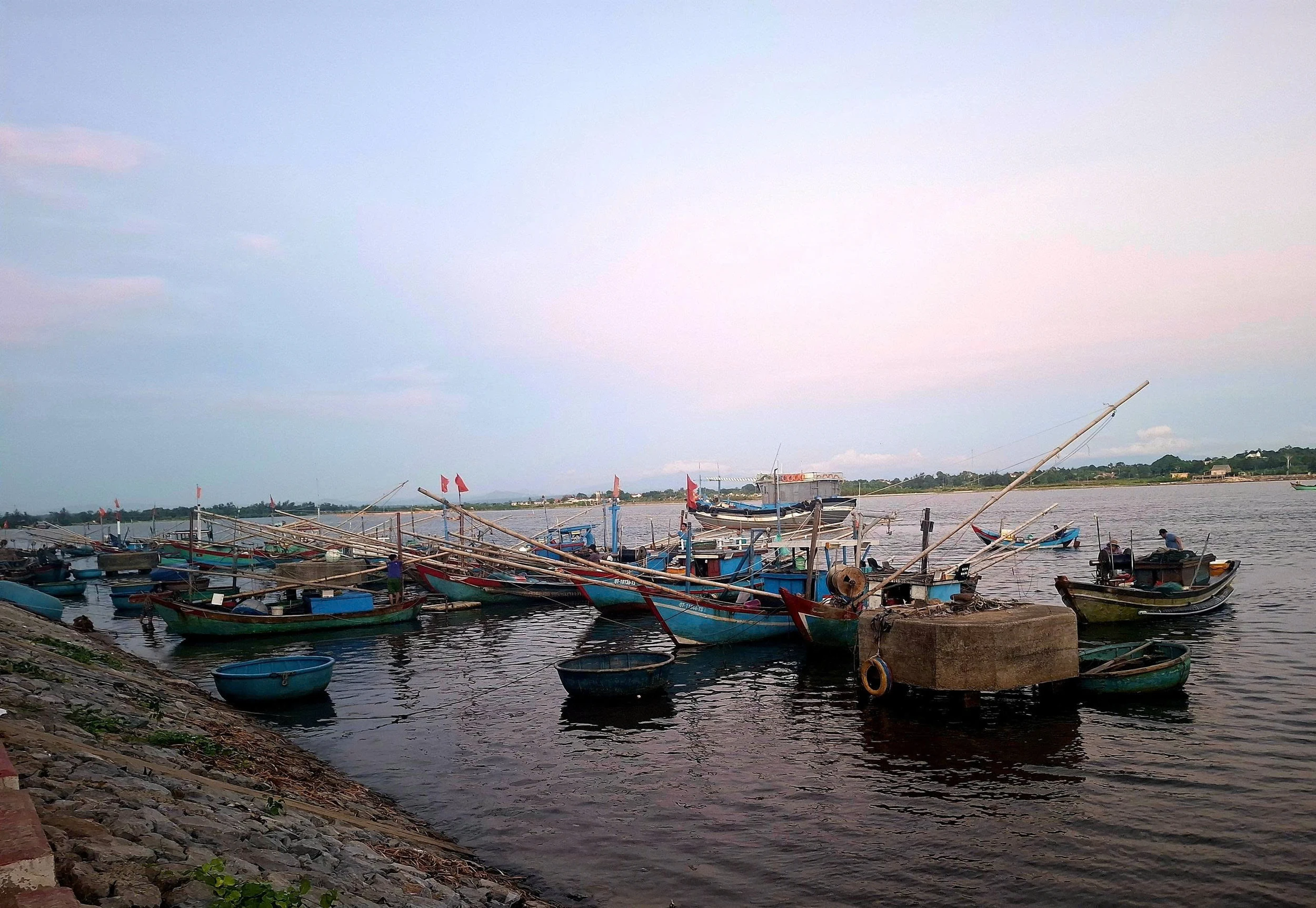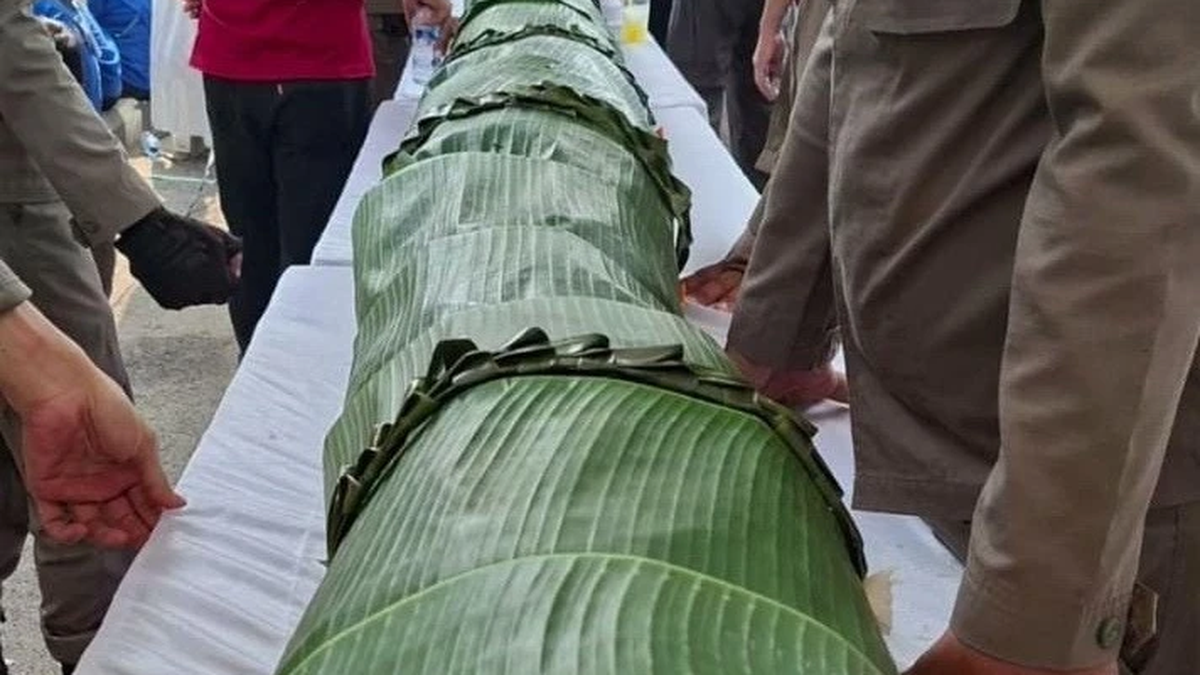Cat Son village boat dock, where fishermen return from fishing for jumping squid and flashing squid after a trip to the sea - Photo: SH
Bring the squid to shore
As dusk gradually fell, the afternoon sunlight cast its shadow on the sea surface, fading. From the storm shelter anchorage of Cua Tung, Cua Tung commune and the boat dock of Cat Son village, Ben Hai commune, groups of squid fishing boats weighed anchor, gently parting the water to head out to sea. Bringing a large battery onto the boat, fisherman Nguyen Van Tuan of Cat Son village, Ben Hai commune took the opportunity to chat with me.
Fisherman Nguyen Van Tuan said that in the past 2 years, fishing for jumping squid and flashing squid has become a high-income profession for fishermen in Ben Hai and Cua Tung communes. Up to now, in Ben Hai and Cua Tung communes, there are nearly 100 fishermen fishing for jumping squid and flashing squid, also known as tube squid.
When caught out of the sea, the squid is still alive and is kept on the boat to be brought to shore to be sold to traders. Then the traders sell it to restaurants and bars to raise in glass tanks, and it is called jumping squid. When caught out of the sea until brought to shore, the squid's body still has sparkling spots like multi-colored phosphorescence, it is called flashing squid. The season for jumping squid and flashing squid usually lasts from April to August of the solar calendar every year.
Fisherman Nguyen Van Thach in Cat Son village, Ben Hai commune, said that squid fishing is not difficult because you only need to invest in a motorboat with a capacity of about 10 - 40 CV to be able to go out to sea. In recent years, fishermen who fish for jumping squid and flashing squid have also started to buy LED light troughs using electricity from batteries with a wide illumination range, reaching dozens of meters deep in the sea, attracting a large number of squid to surface around the light.
On the other hand, motorboats are often made from composite materials with many advantages over traditional bamboo boats. Thanks to that, the amount of jumping squid and flashing squid that fishermen catch is also greater than before.
Another special thing is that fishermen will use fake bait to catch squid. For flashing squid, the bait used is a heavy lead bar as long as an adult's thumb, wrapped in colorful cloth. One end of the lead bar has 4-6 hooks attached, and the other end is tied to a fishing line. It is the lead bars wrapped in colorful cloth that shimmer in the sea water illuminated by LED lights that make the squid mistake the bait for deliciousness and use their tentacles to wrap around it, then get caught on the hook...
Jumping squid fishing tags are made of pieces of fabric woven into the shape of shrimp or grasshoppers with many colorful colors to easily catch the light. When dropping the fishing tag into the water, under the LED light, the squid will be stimulated by the sparkling colors and will use its tentacles to hug the fishing tag tightly like hugging a prey. At that time, the fisherman grabs the tag with one hand, holds the net with the other hand, ready to scoop the squid that follow the bait up to the surface of the water and then release them into a specialized container containing seawater equipped with an aerator near the bow of the boat.
Currently, traders are buying jumping squid at 500,000 VND/kg; flashing squid at 300,000 VND/kg. Fishermen in Ben Hai and Cua Tung communes only need to go out to sea and catch 5-10kg of jumping squid and flashing squid to earn millions after each fishing trip.
Fisherman Nguyen Van Thach's family brings squid to shore to sell to traders - Photo: SH
The amazing story of "squid nest" fishing
Fisherman Le Van Duc in An Duc 1 Quarter, Cua Tung Commune shared that for a long time, whenever mentioning the story of going out to sea to catch squid, many people who do not work in the sea can also imagine the work of fishermen. But there is a story about squid fishing that few people know and is quite interesting, which is "squid nest fishing", for small-capacity boats, fishing about 1 - 3 nautical miles from shore.
The season for fishing for “squid nests” takes place from May to September of the solar calendar every year. Determining “squid nests” mainly depends on the experience of the fishermen. For example, when fishermen use three-net or two-net nets near the shore and see clusters of seaweed and seaweed with dense clusters of squid eggs on them, then in the location where they fish, there will be a “squid nest”. In such cases, fishermen will use a line with one end attached to a lead or heavy stone, and the other end attached to a buoy to locate the “squid nest”. Then, fishermen will call each other to wait until night to bring boats to fish for squid with artificial bait under the light.
When fishing for “squid nests”, there is a taboo that any fisherman must remember: if they catch a “king squid” (usually about 0.8 - 1m long), they must immediately release it back into the sea because according to fishermen, if they do not release the “king squid” back into the sea, the “squid nest” season will never again close at that location.
About ten years ago, just a few nautical miles from shore, it was easy to find a “squid nest” to fish, so every night, fishing boats and ships could catch 2-3 quintals of various types of squid, which was a common thing. But now, “squid nests” are becoming rarer and their stocks are also decreasing because the super bright lights on fishing boats and ships make it difficult for squid to live in concentrated areas.
From early morning, the Cat Son village boat dock was bustling with the laughter of fishermen and traders waiting to buy batches of jumping squid and flashing squid from fishermen on dozens of squid fishing boats returning from the sea. Jumping squid and flashing squid fishing is bringing in high income, contributing to improving the lives of fishermen in Ben Hai, Cua Tung communes and many other coastal communes.
Sy Hoang
Source: https://baoquangtri.vn/ra-bien-cau-muc-nhay-muc-nhay-196146.htm




































































































Comment (0)